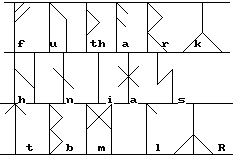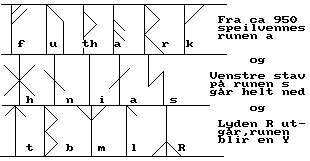The Danish Runes
In Denmark prior to 500 A.D. the 24-rune Elder Futhark was used. From 500 A.D. to 800 A.D. there were many transitional Futharks, reflecting the gradual change from the 24-rune Futhark to the short-branched 16-rune Futharks. By the end of this period, the long-branched 24-rune Futhark had gone completely out of use and the 16-rune Futharks had prevailed. From 900 A.D. onwards some of the runes changed, visually and phonetically. This occurred again in between 950 A.D. and 1100 A.D. due to linguistic changes. Runes dated to 1300 A.D. show evidence of being influenced by the Latin alphabet.
The Elder Futhark, prior to 500 A.D.
|
fehu |
uruR |
şurisaR |
ansuR |
raidu |
kauna |
gebu |
wunju |
hagalaR |
|
naudiR |
isaR |
perşu |
jara |
iwaR |
algiR |
sowilu |
tiwaR |
ehwaR |
|
mannaR |
laguR |
berkana |
ingwaR |
oşila |
dagaR |
|
|
|
The 16-rune Futharks:
One variation of the 500 A.D. - 800 A.D. 16-rune short branched transitional Futharks:
 |
The most prevalent form of runes from ca. 800 A.D. and on in Denmark:
 |
Danish 16-rune Futhark variation from ca. 900 A.D.:
 |
From 950 A.D. the rune a is written mirror-turned and the left stave on the rune s is drawn down to bottom. The rune marked R (sound = z) went out of use and this rune became the sound Y. |
Danish 16-rune Futhark variation from ca. 1100 A.D.:
 |
The Swedish shorttwig-runes influenced the Danish runes as well. |
Danish 16-rune Futhark variation from ca. 1300 A.D.:
 |
You
may use the F also as a V. You may use the G also as a J. You may use the A also as an O. You may use the S also as a C. |